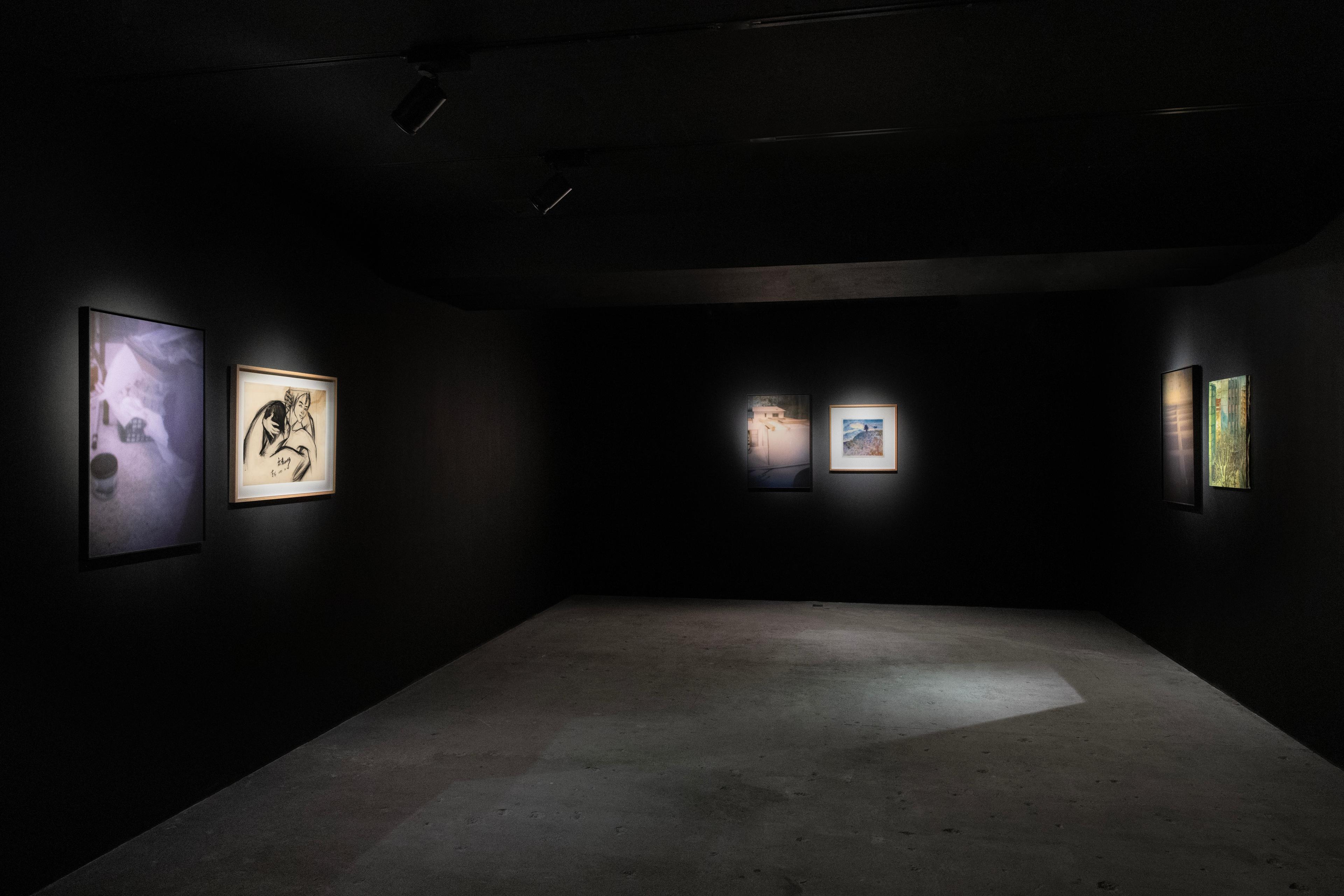What is a child’s duty to a parent’s past, and what is the appropriate distance between two lives? During a visit home to Seattle, the artist and erstwhile art handler Doris Guo (*1992) began preparing for storage a haphazard shipment of paintings her mother, Weili Wang (*1956), had made in Shanghai, before emigrating to the US. Guo, who had previously known little of her mother’s past life as an artist and art professor, said that materially caring for the paintings, while hesitating to organize them into an archive or to call her own involvement documentation, was the least she could do. After that, “I really don’t care what [my mom] does with the paintings,” Guo told me.
Her first solo exhibition in Asia, “Back,” builds on a series of diptychs begun at the Seattle project space Veronica, which traced a familial migration route from Shanghai to Guo’s current residence in Oslo. In Hong Kong, Guo has paired seven of her mother’s paintings and works on paper with prints of pinhole photographs Guo took while sorting through the larger body of works. The selection reflects Wang’s wide range of styles, media, and subject matters from throughout the 1980s, from Social Realist depictions of rural life to figurative charcoal drawings and a variety of landscapes of coastal China. Without being mutually representational, the pairings – the two parts constituting one work, following the Chinese literary tradition of duilian, or antithetical couplets – reflect family resemblances: Stacks of paper folders slanting from their own weight follow farmers toiling in yellowing fields in Autumn Plowing (all works 2023); the boxy pattern in Storagescape (Sunset) mirrors the grids on Chinese apartment blocks; and in Petrichor, the evocation of first rain in a misty Jiangnan village is counterpointed in an unceremonious array of half-covered prints and painter’s tools. In the words of Shanghai-born novelist Liu Yichang, famously appropriated by the opening of Wong Kar Wai’s 2004 film 2046, “All memories are traces of tears.”
Left: Doris Guo, Daydream dwelling, 2023, giclée print on Arches 310 gsm paper; right: Weili Wang, 究竟如何 How, 1982, charcoal on paper.
Left: Doris Guo, Monroe Studio Model, 2023, giclée print on Arches 310 gsm paper; right: Weili Wang, 风景 Landscape, 1987, watercolor and mineral pigment on rice paper
Left: Doris Guo, Storagescape (Sunset), 2023, giclée print on Arches 310 gsm paper; right: Weili Wang, 夕阳红 City Sunset, 1982, oil on canvas
The blackened walls and darkened interior of Empty Gallery characteristically lend its displays a meditative solemnity, here especially pronounced by two custom-built projector-sculptures in the exhibition’s anteroom. Static close-ups of the sleek, metallic curvature of a call bell in Anti Discarnate and blurry, purple-toned accessories seen through an air vent in Fallen Jewelry recast scenes of domestic turmoil as a dry, situational comedy, the way children, especially immigrant children, distort private jokes to cope with the aporia of living between worlds. The latter image especially summarizes a tragicomic distance: Like memories of the past or unacknowledged family histories, objects seemingly within physical reach can remain emotionally a universe away.
Reading the distance between the vivacity of Wang’s self-assured, en plein air exercises and Guo’s cooler, compositionally erratic, often out-of-focus photographs of messy interiors, unnamed objects, and studio miscellany, the opening of a poem by Ariana Reines sprang to mind: “Trying to see the proportional relation / Of one memory to another / One is so strange, and then / To try and see what looms / And doesn’t for the other person.” Evading a confrontation with the facts of documentation and the tidiness of an archive, the photos appear rather as portals into a dream state, echoing the sultry impossibility of grasping the reality of the spacetime their referents – her mother’s life and work – once occupied.Guo gracefully resolves the incumbent tensions between these multiple identities and their limited perspectives by unburdening their respective artistic languages of the didactics of interpretation. By choosing not to complete Wang’s narrative, Guo’s formal and material focus deposes her own voice in reckoning with their relationship. Moreover, by maintaining a respectful opacity between her work and her mother’s life, Guo asserts an equality of discursive agency in their collaboration as artists.
Doris Guo, Anti Discarnate, 2023, call bell, copper drain, opaque projector, painted wood, and hardware
Doris Guo, Fallen Jewelry, 2023, jewelry, metal vent, opaque projector, stained wood, and hardware
The discreet humor and formal instincts in “Back” reason that familial decisions at once practical and sentimental need not be saccharine. Nor, for that matter, must viewers always consent to playing the role of psychoanalyst, even when reckonings with filial guilt, generational trauma, and unspoken histories – all common to the Asian-American experience – become artistic subjects. Posing herself in relation to family, and complicated by the multiverse of immigration, Guo proposes an alternative grammar that liberates the viewer and the child-as-artist from the duty of making sense. We may not always fully understand the choices made in the past, beholden as we are at any given moment to the perspective of any one identity; Guo’s clear conceptualization of this limitation shows how the material of the personal can transcend the blind spots of the autobiographical. What if the artist’s structuring role is such that two lives may find a common language, in which one is expressly permitted to move as freely as the other? We suffer because we don’t know how to lovingly leave each other alone.
View of “Back,” Empty Gallery, Hong Kong, 2023
___
“Back”
Empty Gallery, Hong Kong
9 Dec 2023 – 17 Feb 2024








